Femia > Health Library > Getting Pregnant > Trying to conceive > How to know when ovulation is over for better pregnancy planning
How to know when ovulation is over for better pregnancy planning
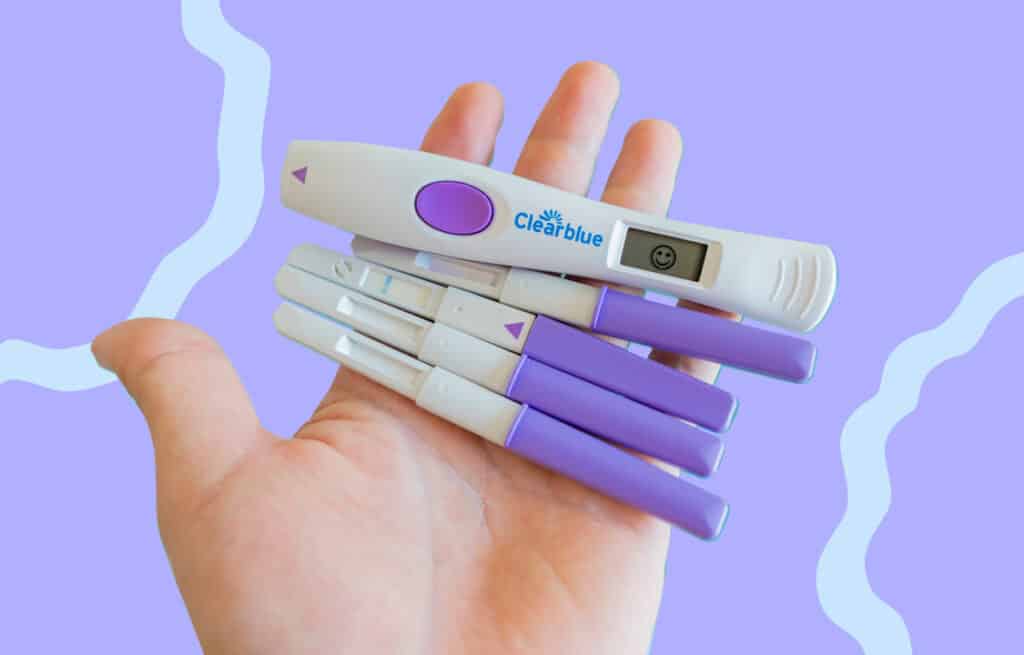
- Updated Feb 19, 2025
- Published
CRAFTED BY HUMAN
Crafted by human At Femia, we provide accurate and up-to-date information at every stage of your journey, from trying to conceive, pregnancy and postnatal support. All content is created by a real person based on in-depth research and own professional experience. Femia ensures that you will receive expert advice, strict accuracy and a personalized approach from our authors/medical experts. Learn more about our editorial policy.
FACT CHECKED
Fact checked At Femia Health, we maintain the highest standards of editorial excellence in delivering content focused on helping you conceive, guiding you through pregnancy, and supporting you postpartum. Explore our content review principles to learn how we ensure the accuracy and quality of our health and lifestyle tips for every stage of your journey.
- Ovulation is when a mature egg is released from the ovary, typically around day 14 of a standard 28-day cycle.
- Knowing when ovulation ends is important for those trying to conceive or avoid pregnancy because the egg is only viable for 12–24 hours post-release.
- Signs ovulation is over may include changes in cervical mucus (from stretchy to thick or dry), a rise in basal body temperature, and breast tenderness. Tracking these signs can help you to manage your reproductive planning.
Ovulation, as a key part of a woman’s menstrual cycle, happens when a mature egg is released from the ovary. Knowing your menstrual cycle, when you ovulate, and planning sex accordingly significantly increase your chances of getting pregnant. Now let’s dive deeper into the topic to understand what happens during ovulation, its meaning for pregnancy, and signs that ovulation is over.
Use Femia’s easy-to-use ovulation tracker, symptom log, and daily insights
to understand your fertility better and increase your chances of conception
What happens during ovulation?
Ovulation is one of the phases in the menstrual cycle, and it occurs when your ovary releases an egg (ovum). When considering an average 28-day cycle, you can expect ovulation to happen around day 14.
The process starts when a part of the brain (called the hypothalamus) releases gonadotropin-releasing hormone (GnRH). This hormone causes your pituitary gland (also located in the brain) to produce follicle-stimulating hormone (FSH) and luteinizing hormone (LH).
The process looks like this:
- Days 6-14: FSH stimulates multiple follicles (fluid-filled sacs containing immature eggs) in both ovaries to begin maturing. Usually, only one follicle becomes dominant and reaches full maturity.
- Days 10-14: Only one of these follicles forms a fully mature egg.
- Around day 14: Around ovulation day, a surge in LH triggers the final maturation of the egg and its release from the dominant follicle. This egg release creates 12–24 hours for intimacy to happen for a higher chance of getting pregnant.
- After ovulation: Progesterone levels rise, supporting the thickening of the uterine lining in preparation for a potential pregnancy.
After ovulation, the egg is released into the fallopian tube, where it may encounter sperm and undergo fertilization. If fertilization occurs, the developing embryo travels to the uterus over the next several days and typically implants into the uterine lining between 6 to 10 days after ovulation.
👉Find out more: Ovulation pain and pregnancy success: What it means for your fertility
After ovulation, the corpus luteum releases progesterone, which helps maintain the uterine lining for possible embryo implantation. The fertilized egg, now called a zygote, begins dividing into multiple cells. Some of these will develop into the embryo, while others form the placenta.
If implantation occurs, the embryo releases human chorionic gonadotropin (hCG), which signals the body to maintain the uterine lining, preventing menstruation. Therefore, not getting a period is often the first sign you’re pregnant.
Physical signs ovulation is over
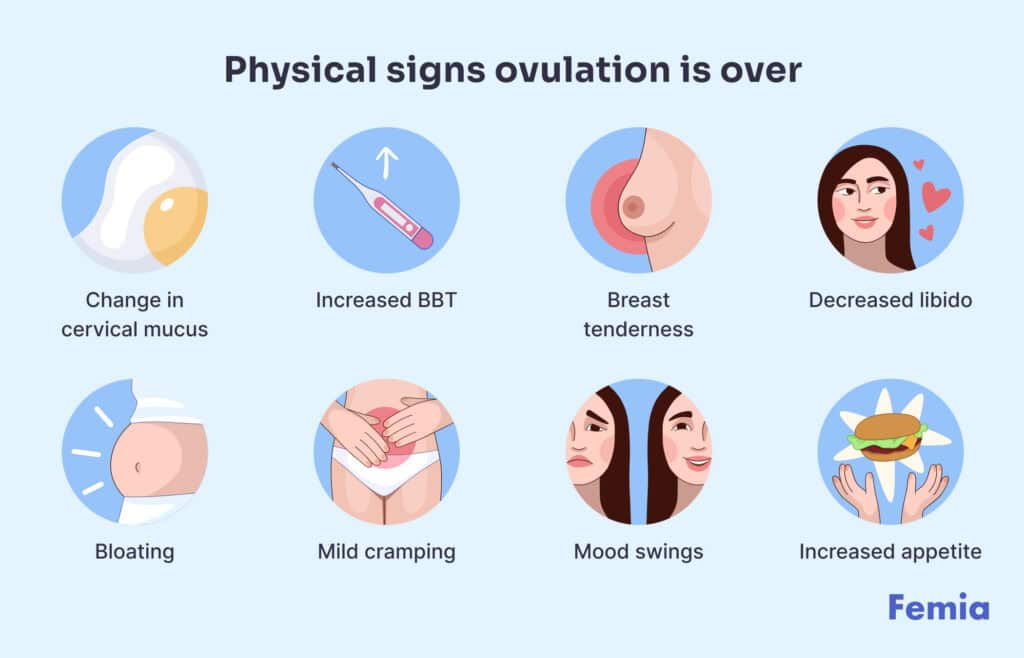
Once ovulation occurs, your body undergoes many changes because of hormonal shifts. Here are some of the most noticeable indicators how to tell when ovulation is over:
- Change in cervical mucus: It changes from being slippery and stretchy, similar to egg whites – to thicker, creamier, or even dry. This mucus indicates that the fertile window has passed.
- Basal body temperature (BBT): It is the lowest body temperature attained during rest and is usually estimated by a measurement right after you wake up in the morning. BBT rises slightly (by about 0.5°F to 1°F) because of the increased progesterone levels. This temperature rise often shows that ovulation has already occurred.
- Breast tenderness: Growing progesterone levels after ovulation make the breasts feel swollen or sore. This symptom may also result from hormonal fluctuations between estrogen and progesterone.
There are other less noticeable signs ovulation is over that may also be confused with feeling ill, so consider them in combination with those listed above. Here are some symptoms to keep an eye on:
- Decrease in libido
- Bloating or mild cramping
- Mood swings
Hormonal changes after ovulation
Hormonal levels shift gradually after ovulation, primarily due to an increase in progesterone, which prepares the uterus for a potential pregnancy. Estrogen levels may temporarily dip before rising again later in the luteal phase. This increase also often causes a rise in basal body temperature, which remains elevated until the next cycle begins. That’s why many women experience a sense of calm or lower energy levels, which is completely opposite to the high-energy, horny, and sociable feeling experienced during ovulation.
This shift may also cause the following symptoms:
- Increased appetite due to rising progesterone.
- Mood fluctuations, making you more emotional, sensitive, or sometimes anxious.
- Bloating, as progesterone can cause fluid retention.
- Slower digestion and mild constipation, as progesterone relaxes smooth muscle tissue, affecting gut motility.
What is the last day of ovulation?
The last day of ovulation is the final 24 hours when an egg remains viable for fertilization before it breaks down. Last day of ovulation symptoms include:
- Changes in cervical mucus can give you a clue that it’s your last day as it transitions from being clear and stretchy like egg whites to a thicker or drier consistency.
- Some may also experience post-ovulation pain because of the egg breakdown, which may be similar to menstruation pain but usually from one side of the belly.
- Tracking your basal body temperature (BBT) is a reliable way to confirm that ovulation has already occurred, as a sustained temperature rise indicates the transition into the luteal phase.
The most effective way to predict ovulation is by using ovulation test strips (LH tests), which detect a surge in luteinizing hormone (LH) that signals ovulation is likely to occur within 12–36 hours. However, these tests cannot confirm if ovulation has actually happened.
Use Femia’s easy-to-use ovulation tracker, symptom log, and daily insights
to understand your fertility better and increase your chances of conception
Can you get pregnant after ovulation?
One of the biggest questions around this topic is can you get pregnant after ovulation is over. Pregnancy is possible 12–24 hours after ovulation. This is because the released egg can only survive 24 hours before sperm can no longer fertilize it as the egg remains viable for fertilization during this period. After this time, the egg degenerates and can no longer be fertilized. Sperm can live up to 5 days, but fertilization is only possible within 12–24 hours after ovulation.
Pregnancy is unlikely outside the ovulation window. However, if sperm are present in the reproductive tract before ovulation, fertilization can still occur once the egg is released. That’s why, when planning to become pregnant, it’s important to plan intimacy according to your cycle, identifying your fertility window for higher chances of successful conception. For the best chance of conception, timing intercourse during the fertile window—particularly in the two days leading up to ovulation—is crucial.
👉Find out more: Best sex positions to get pregnant: Tips for optimizing conception
How to track your cycle to determine ovulation and when it's over
Here are some tools and methods for those wondering “How do you know when ovulation is over?”:
- Apps: There are many period tracking apps like Femia that are great for calculating your cycle each month and predicting ovulation based on previously collected data and symptoms.
- LH strips: These test your urine for luteinizing hormone (LH), which increases 24-36 hours before ovulation.
- BBT tracking: Tracking basal body temperature (BBT) daily can help confirm that ovulation has already occurred, as a sustained increase in temperature indicates the luteal phase has begun.
- Cervical mucus observations: Mucus becomes clear, stretchy, and egg-white-like during ovulation. It becomes thicker and darker once ovulation is over.
Next steps after ovulation
The luteal phase begins immediately after ovulation and typically lasts 12–14 days. During this phase, progesterone levels rise to prepare the uterus for a potential pregnancy. During this phase, if fertilization occurs, the fertilized egg (zygote) travels through the fallopian tube toward the uterus. If the egg is not fertilized, it remains in the fallopian tube and is reabsorbed by the body.
If sperm fertilizes the egg, it becomes a zygote and begins dividing as it moves toward the uterus. Pregnancy occurs only if the embryo successfully implants into the uterine lining, typically 6–10 days after ovulation.
If the egg is not fertilized, it disintegrates in the fallopian tube. If fertilization occurs but the embryo does not implant, progesterone levels drop, leading to the start of the next menstrual period.
If you had sex during ovulation, then you may want to track if there was a successful conception. This can be done by taking a pregnancy test at the appropriate time. Most pregnancy tests can detect hCG from the first day of a missed period. Some highly sensitive tests may provide results as early as 10–14 days after ovulation. Some very sensitive pregnancy tests may be used even before the first symptoms, like a missed period.
Questions from the Femia community
Can ovulation symptoms last after ovulation is over?
Yes, symptoms like mild cramping or changes in cervical mucus can persist for a day or two after ovulation due to hormonal shifts. It's a normal process and only requires seeking medical help when such symptoms are present for longer than two days.
How does stress affect ovulation and cycle tracking?
Stress can impact the menstrual cycle by delaying or even suppressing ovulation, leading to irregular cycles, including late or missed periods. In rare cases, significant hormonal disruptions may cause breakthrough bleeding, which may be mistaken for a second period in the same month. If ovulation is delayed due to stress, the entire cycle may be extended, resulting in a later-than-expected period.
What are the chances of pregnancy if ovulation just ended?
Although it is unlikely for pregnancy to occur if ovulation has already ended, as the egg can only be fertilized within 12–24 hours, there are some rare cases when it is still possible as the sperm stays in the woman's reproductive system for up to 5 days.
Does basal body temperature drop immediately after ovulation ends?
Basal body temperature usually remains elevated after ovulation due to progesterone until your next period. Basal body temperature remains elevated after ovulation due to increased progesterone and typically stays high until the start of the next menstrual period unless pregnancy occurs.
The bottom line
Understanding when ovulation ends is essential for effective family planning, whether you’re trying to conceive or prevent pregnancy. Signs ovulation is over discharge consistency changes (becoming thicker or dry), a sustained rise in basal body temperature, and hormonal shifts, particularly an increase in progesterone levels. Regularly tracking your cycle using methods like BBT monitoring, LH strips, or fertility apps can improve your understanding of ovulation patterns. While these tools enhance accuracy, they should be used in combination with other reproductive health indicators for the best results.
References
- Cleveland Clinic. “Hypothalamus: What It Is, Function, Conditions & Disorders.” Cleveland Clinic, 16 Mar. 2022, my.clevelandclinic.org/health/body/22566-hypothalamus.
- Cleveland clinic. “Gonadotropin-Releasing Hormone (GnRH).” Cleveland Clinic, 18 Mar. 2022, my.clevelandclinic.org/health/body/22525-gonadotropin-releasing-hormone.
- Cleveland Clinic. “Follicle-Stimulating Hormone (FSH): What It Is & Function.” Cleveland Clinic, 23 Jan. 2023, my.clevelandclinic.org/health/articles/24638-follicle-stimulating-hormone-fsh.
- Cleveland Clinic. “Luteinizing Hormone: Levels, Function & Testing.” Cleveland Clinic, 1 Aug. 2022, my.clevelandclinic.org/health/body/22255-luteinizing-hormone.
- Cleveland Clinic. “Fallopian Tubes: Location, Anatomy, Function & Conditions.” Cleveland Clinic, 6 July 2022, my.clevelandclinic.org/health/body/23184-fallopian-tubes.
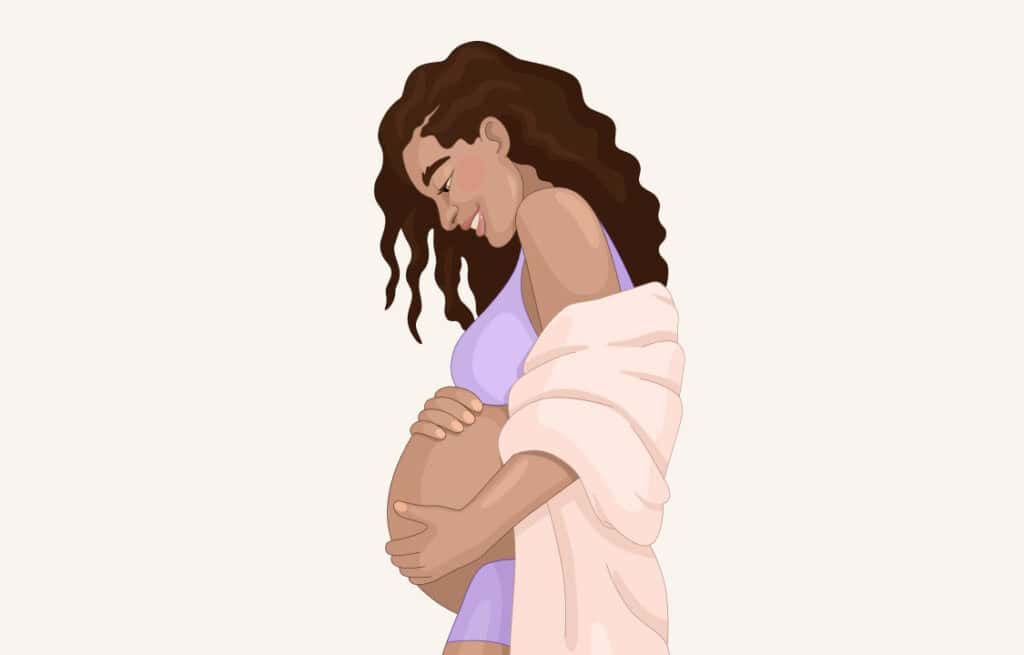
Discover what quickening is in pregnancy, when to expect it, and what it feels like. Learn how to monitor your baby’s first movements and when to consult your doctor about any concerns.
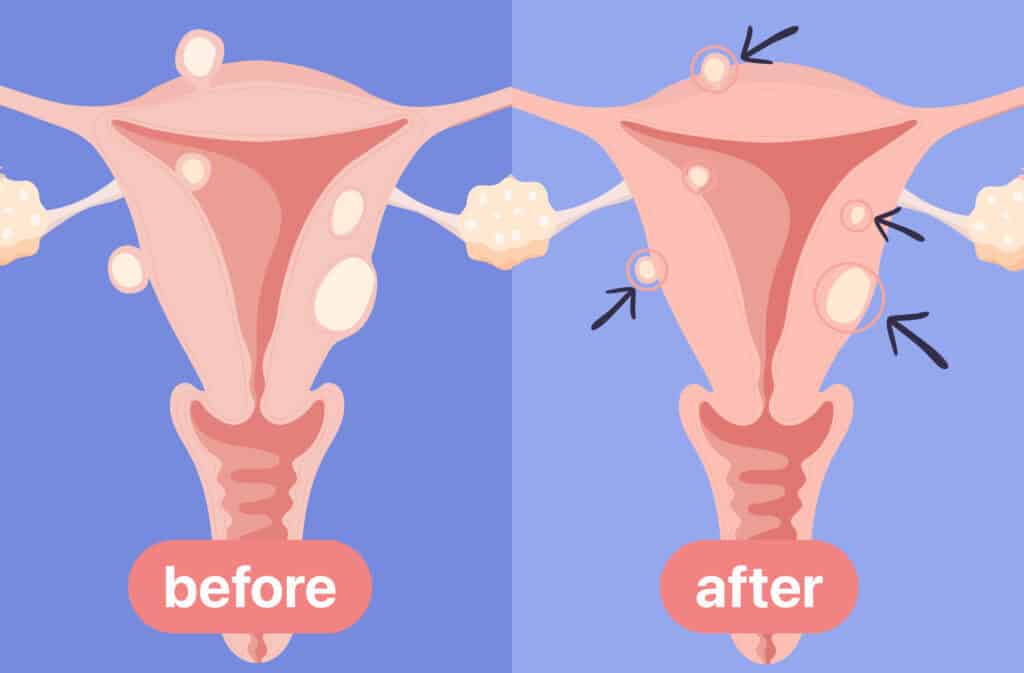
Discover how to shrink fibroids naturally at home with diet, lifestyle changes or medical treatments and when to see a doctor.
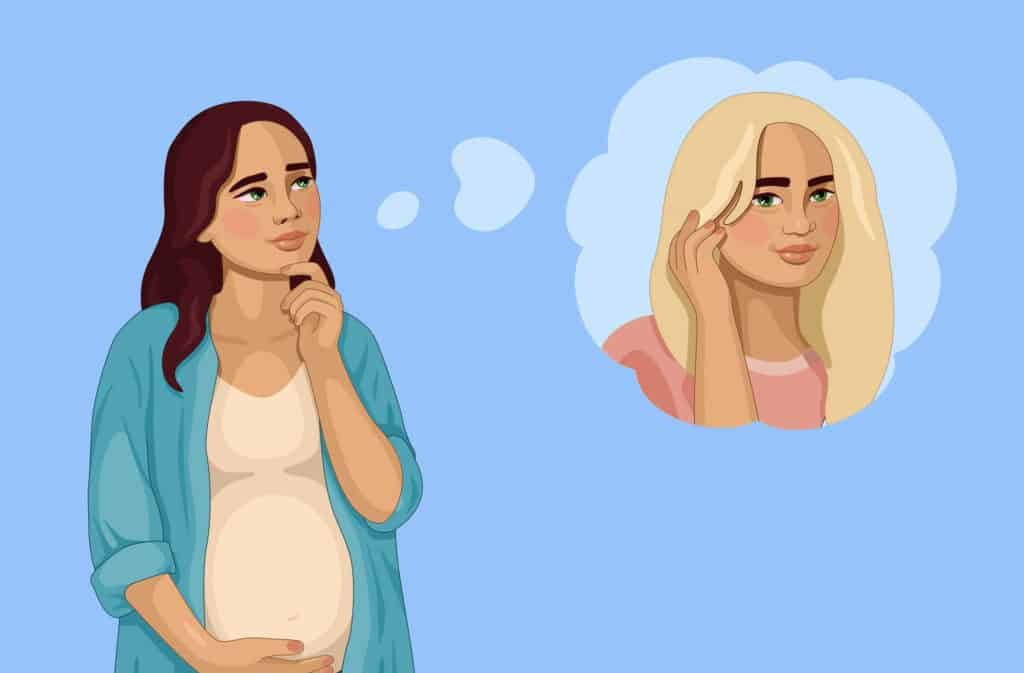
Many wonder, is it safe to dye your hair while pregnant? You can take precautions to protect yourself and your developing baby from chemical exposure.

